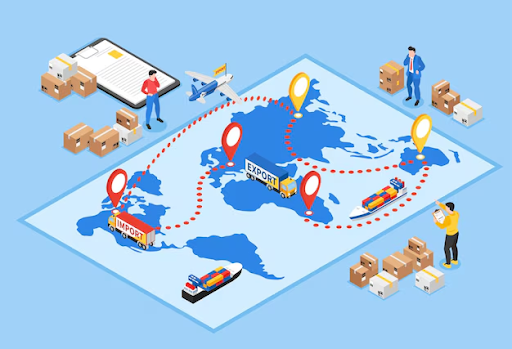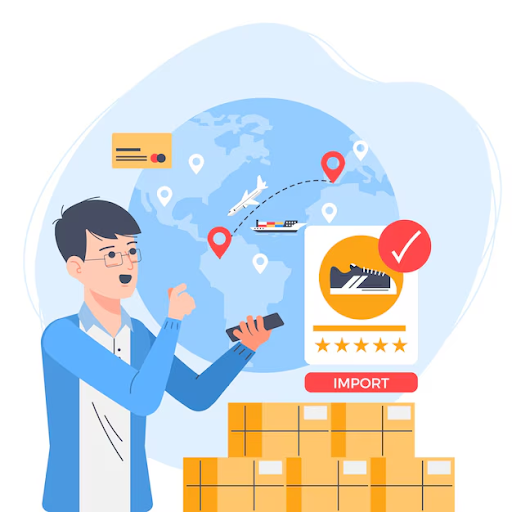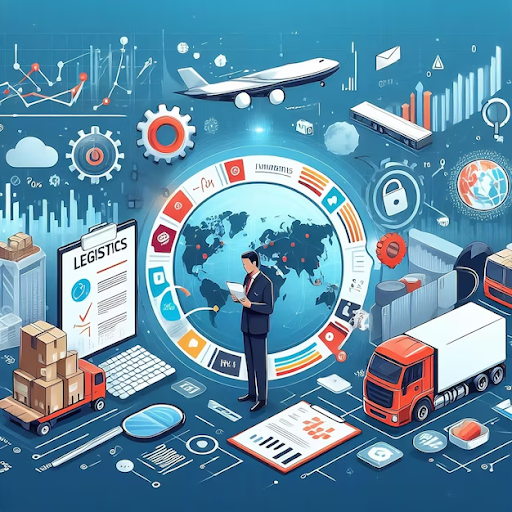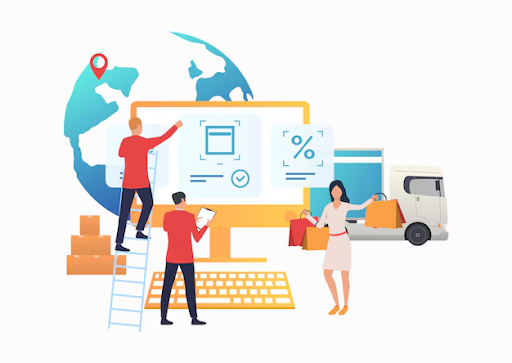In this article, let's explore with Sota Solutions the reasons why logistics businesses need to undergo digital transformatiosformation.
1. What is digital transformation?
Digital transformation is a comprehensive and extensive process that changes the way organizations, businesses, and individuals operate, based on the application of digital technology in all aspects of life. Instead of simply using technology to automate tasks, digital transformation aims to change business models, create new values, and improve operational efficiency.
Example of digital transformation:
- In production: Using robots and artificial intelligence to automate the production process, minimize errors, and increase productivity.
- In commerce: Online sales, electronic payments, digital marketing.
- In the service: Providing online customer service, using chatbots to assist customers.
- In management: Using enterprise resource planning (ERP) software, customer relationship management (CRM),...
2. Digital transformation in logistics: No longer a trend but a necessity

Have you ever wondered how a shirt you ordered online can reach you so quickly and accurately? That is precisely thanks to the application of digital technology in the logistics industry.
Digital transformation in logistics simply involves applying modern technologies to digitize and automate processes in the supply chain, from the stages of receiving goods, warehousing, transportation to delivery. Thanks to that, logistics companies can optimize operations, reduce costs, and enhance customer experience.
Some core technologies in the current digital transformation of logistics include:
- Internet of Things (IoT): Helps connect and track goods, transportation vehicles, warehouses... throughout the transportation process.
- Artificial Intelligence (AI): Automating processes, predicting demand, optimizing routes, and managing inventory efficiently.
- Big Data: Collecting and analyzing large amounts of data to make accurate business decisions.
- Blockchain: Ensuring transparency and security for transactions in the supply chain.
- Robot: Automate repetitive tasks, increase productivity, and minimize errors.
Leading companies like Amazon and DHL have successfully applied these technologies to build modern and intelligent logistics systems. For example, Amazon uses robots to organize goods in warehouses, leveraging AI to predict customer demand and optimize the delivery process. DHL uses blockchain to ensure transparency in the transportation of high-value goods.
3. Five reasons logistics companies need to digitize?
3.1 Increase operational efficiency
Automating processes: The application of technologies such as IoT and AI in warehouse management, transportation, and delivery helps automate most processes. From inventory management, tracking vehicle locations, to order management, everything is done quickly and accurately, minimizing human intervention as much as possible.
Optimizing routes, reducing transportation costs: Smart transportation management software has the ability to calculate and select the shortest routes, avoid traffic jams, helping to minimize fuel costs and transportation time. At the same time, optimizing the delivery schedule also helps increase the productivity of the fleet.
Improve data accuracy, minimize errors: With a centralized data management system, information about goods, orders, and customers is continuously and accurately updated. This helps eliminate errors in the delivery process, enhancing customer trust.
3.2 Improving Customer Experience
Track orders online, provide updates: Customers will no longer have to worry about the status of their orders. Thanks to smart transportation management systems, they can easily track the journey of goods from the moment the order is placed until it is received. Information is continuously updated, helping customers to be more proactive in planning.
Customize services according to each customer's needs: Each customer has different needs. Digital transformation helps logistics companies analyze customer data, thereby providing appropriate product and service recommendations. Customers will feel more cared for and satisfied when they receive personalized services.
Enhancing customer service quality: Automating processes, minimizing errors, and shortening delivery times will help logistics companies improve customer service quality. In addition, online customer service channels such as chatboxes and emails also help customers resolve their inquiries more quickly and conveniently.
3.3 Enhancing competitiveness
Increase delivery speed: Automated warehouse and transportation management systems help shorten the time from order receipt to delivery, meeting the demand for fast delivery from customers, especially in the era of developing e-commerce.
Enhancing accuracy: Tracking and monitoring technologies ensure that goods are delivered in the correct type, quantity, and on time to their destination. This not only minimizes the risk of loss but also enhances customer trust.
Differentiating products and services: Digital transformation helps logistics companies create value-added services such as online tracking of goods, demand forecasting, and customizing services for each customer, thereby creating a difference compared to competitors.
Market expansion: With the ability to connect and integrate with other systems, logistics companies can easily expand their market and reach new customers in different geographical areas. At the same time, providing multi-channel services also helps businesses attract a wider range of customers.
3.4 Ensuring sustainability
Minimize environmental impact: To achieve sustainable development, logistics companies need to balance economic profit and social responsibility. Digital transformation is the perfect bridge for businesses to achieve this goal. By applying technological solutions such as IoT, AI, and Big Data, businesses can optimize operations, minimize waste, and contribute to reducing harmful carbon dioxide emissions that damage the environment. This not only helps businesses save costs but also contributes to environmental protection and builds a positive brand image in the eyes of the public.
Enhancing transparency in operations: Transparency is a core factor in building a reliable logistics brand. Digital transformation provides tools to effectively monitor and manage the entire supply chain, from the procurement stage to delivery. Customers can easily track their orders anytime, anywhere, ensuring that the goods are transported safely and on time. In addition, digitizing data also helps businesses easily retrieve information, serving for auditing and reporting, contributing to enhancing the transparency and social responsibility of the enterprise.
3.5 Compliance with regulations and risk mitigation
In the logistics industry, compliance with regulations on customs, taxes, and cargo safety... is extremely important. A small mistake can also lead to serious consequences such as fines, loss of reputation, or even shutdown. In the past, managing these regulations often encountered many difficulties due to dispersed information, continuous changes in regulations, and the risk of manual data entry leading to errors, causing issues in the customs clearance and payment processes. When a problem occurs, retrieving information to identify the cause and assign responsibility is very difficult.
But thanks to digital transformation, the above issues have been easily addressed with a centralized information management system. Modern logistics management software helps centralize information about regulations, goods, customers... making it easy for businesses to update and retrieve information when needed. Many manual tasks such as data entry, checking, and calculations are automated, reducing errors and increasing productivity. Additionally, the logistics management system can integrate with other systems such as the electronic customs system, banking system... helps shorten processing time and increase accuracy.
For example, a logistics company specializing in transporting goods for export to the European market. In the past, customs declaration and document inspection were a complex and time-consuming process. Since implementing the integrated logistics management system, the company has automated the entire process. Thanks to that, the customs clearance time has been significantly shortened, reducing the risk of goods being held or fined. At the same time, the system also helps businesses monitor the status of goods anytime, anywhere, ensuring that products reach customers on time and safely.
4. The biggest challenges in digitizing the logistics industry

High investment cost
The investment cost for digital transformation includes many different items. In addition to the initial costs for hardware and software, businesses also have to face maintenance costs, system upkeep, and technology upgrade costs when new versions are released. In addition, retraining the staff to adapt to new technology is also an unavoidable expense.
Shortage of skilled labor
The reality shows that many logistics companies are facing a shortage of skilled labor. Imagine a logistics company that has just invested in a modern automated warehouse management system. This system requires employees to have knowledge of programming, data analysis, and the ability to operate specialized software. Meanwhile, the company's current staff mainly have experience in traditional warehouse management. This skills gap creates a significant barrier, making the implementation of the new system difficult and prolonging the timeline.
The shortage of skilled digital workforce not only slows down the digital transformation process but also leads to operational errors, causing waste and reducing efficiency.
Difficulties in changing mindset and work culture
For logistics companies, which are accustomed to traditional processes, this change often encounters many difficulties. For example, an established transportation company has decided to implement a warehouse management system using software. Initially, the warehouse staff were very hesitant to get accustomed to the new interface and the data entry method, which was completely different from the previous paper records. They fear that they will not be able to adapt and will make many mistakes. This leads to delays in the transition process and affects work efficiency.
Changing mindsets and work culture is a process that requires patience and effort from both managers and employees. However, if this can be achieved, businesses will be able to fully leverage the benefits of digital transformation and achieve outstanding success.
5. Optimizing logistics through digital technologies

Investing in technology
To succeed in the digital transformation game, logistics companies need to develop a clear strategy, invest in technologies such as IoT (Internet of Things), apply artificial intelligence (AI) and machine learning, and other management software.
For example, a traditional freight transportation company once faced difficulties in managing orders, tracking journeys, and providing updates to customers. After realizing these limitations, they decided to invest in a modern transportation management system. This system helps automate processes, from order reception, route planning, vehicle tracking to delivery and payment. Thanks to that, the business has minimized errors, enhanced transparency in the transportation process, and improved customer experience. Another example, to optimize the process, that transportation company could also apply IoT technology to track the journey of goods and provide real-time updates to customers. This idea makes your process faster, and customers feel more satisfied with the company's service.
Human resource training
Mastering technology and having a well-trained team will help businesses enhance their competitive edge, optimize processes, and deliver added value to customers.
For example, in the past, businesses mainly used manual management methods, recording information on paper and using simple software to track orders. This leads to many limitations such as lack of transparency, paperwork risks,...Therefore, when investing in technology and training employees, the staff applied IoT technology to monitor temperature and humidity during the transportation of frozen goods. Thanks to that, the company has minimized the situation of damaged goods, ensured product quality, and enhanced the brand's reputation.
Building a digital corporate culture
In the digital age, building a digital corporate culture has become more important than ever. To adapt to the ever-changing market and meet the increasing demands of customers, logistics companies need to create a working environment that encourages innovation, creativity, and the application of technology. Instead of just focusing on maintaining existing processes, businesses need to create a solid foundation for new ideas to have the opportunity to develop.
6. Sota FMS - the leading logistics management solution
The Freight Forwarder Management System (FMS) software is the leading enterprise management solution from the technology company Sota Solutions. With many years of experience in developing ERP business management solutions, Sota FMS has been comprehensively designed by our team to help logistics companies optimize their operational processes with powerful features such as financial management, CRM, order management, quotations, supplier management, and real-time reporting. FMS is an effective solution that enhances customer experience, manages costs, and improves decision-making capabilities for businesses in the logistics industry.
Thanks to its professionalism and dedication, Sota Solutions' Sota FMS software helps transportation and logistics businesses optimize their operational processes, manage costs effectively, and enhance service quality, creating a solid foundation for sustainable development in the logistics industry.
7. Conclusion
In summary, in the digital era, digital transformation is no longer an option but a guiding principle that helps businesses enhance their operational efficiency. By fully leveraging technology, businesses not only optimize operations but also pioneer the future of the transportation industry, delivering exceptional experiences to customers. Let's contact us for the best digital transformation solutions for your logistics business.
